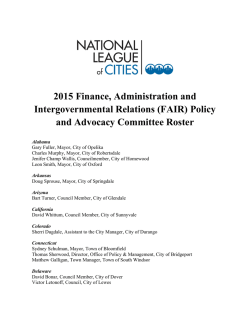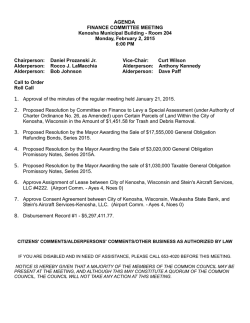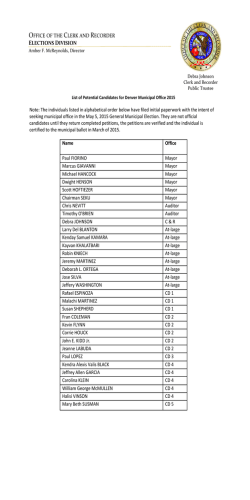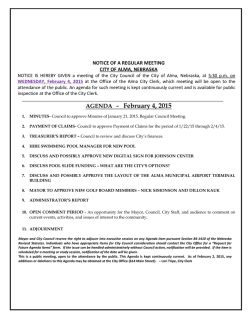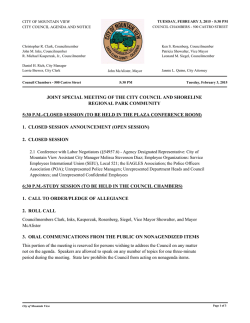
Welcome_files/February Newsleetter
GEOLOGISTS OF JACKSON HOLE FEBRUARY NEWSLETTER Using his new back-yard observatory here in Jackson, GJH Member Mike Adler recently captured this image of Messier 81, a large spiral galaxy in our neck of the cosmic neighborhood. It is interesting to note that what we can see today (through Mike’s lens) is an 11.8 million year-old image, proving that we can sometimes see the past better than the present. THE PAST INFORMS THE FUTURE In 1933, Kotaku Wamura survived a devastating tsunami in his hometown of Fudai, Japan. He eventually became the village’s mayor and held the post for four decades. He was popular enough to keep his job but he went to his grave shouldering the weight of much public ridicule for spending an unbelievable 3.56 billion yen to build a 51-foot high sea wall designed to protect his village from tsunamis. Completed in 1984 and dubbed “Wamura’s folly” by some, the wall was much higher than anything erected by other villages in the area and was widely regarded as a monument to government wastefulness and arrogance. Mayor Wamura, who died in 1987 at the age of 88, defended to his last breath the wisdom of the wall. “In the end," he said at his retirement party, “people will understand.” That understanding arrived on March 11, 2011, when the great Sendai earthquake and tsunami wiped out the villages to the north and south of Fudai, which emerged from the crisis unscathed. Now, Fudai townsfolk regularly visit Mayor Wamura’s grave to pay their respects to the man who came back from the dead to save them all. Naturally, this story resonates with GJH. We wonder what threats Kotaku Wamura might address if he were the metaphorical mayor of Teton County. How can the past inform our future? To this end, this month we will examine two candidates worthy of Mayor Wamura’s attention: volcanic fallout and the Teton fault. This Tuesday (2/3/15) at the Teton County Library Auditorium at 6:00 pm, Idaho State University geology Professor Shannon Kobs-Nawotniak will be here to talk about the hazards associated with volcanic ash and debris, and how modeling tephra dispersal and deposition in realistic eruption scenarios may help us to prepare for the unexpected but inevitable volcanic baptism lurking somewhere in our future. Come on over to the Library this Tuesday to sharpen your own inner-Wamura. ISU Professor Kobs-Nawotniak will visit this Tuesday Other News We Live With Science Superstars Fellow GJH member James “B.J.” Bjorken is no stranger to most of the people reading this newsletter. He is well-known for his insightful geologic interpretations of the paleozoic rocks on the west flank of the Teton range and his geology lectures are captivating. Peter Ward alerted the Board this week to a well kept secret: BJ is also internationally recognized as a trail blazer in physics. Last Thursday, Professor Bjorken was awarded the super-prestigious Wolf Prize for his ground breaking work in particle physics. The following comes from the Jerusalem Post: "The Wolf Prize has gained international prestige; in the sciences, it is considered second in importance to the Nobel Prize, with more than a third of recipients going on to win the Nobel. In the arts, it is regarded as the most important award. Bjorken was praised for 'predicting scaling in deep inelastic scattering, leading to identification of nucleon’s pointlike constituents. He made a crucial contribution for elucidating the nature of the strong force. In 1967 Bjorken predicted that electrons scattering violently off protons would exhibit the so-called scaling behavior, as if they were interacting with pointlike, charged and quasi- free particles inside the nucleon.' At the time this was 'a very counterintuitive and radical idea, yet, subsequent experiments carried out in the late ‘60s provided a stunning confirmation for Bjorken’s scaling prediction. Scaling not only led to the discovery of quarks, but also pointed the direction toward the mathematical framework governing all fundamental interactions.’ " http://www.jpost.com/Israel-News/Health/Wolf-Prizes-in-the-sciences-and-arts-presented-to-nine-North-Americans389466 February Members’ Lunch Wednesday, 2/18/15 Mike Adler will talk about Our Universe: Its Spectacular Beginning and Likely Dismal, Dark Ending at the National Museum of Wildlife Art, 11:00 am, WEDNESDAY 2/18/15. More on this with the next newsletter, but for all members who have enjoyed Mike’s presentations in the past, no more need be said. GJH Website Committee looking for more help GJH Web Master Dan Heist has updated our website with presentation materials from several of our more recent lectures, updated program schedules, and other relevant links: < Welcome >. That said, the expansion of our website and the increasing volume of material planned for inclusion in the future have Dan and his group looking for more volunteers. If you have experience building websites the GJH website committee would welcome your help. Contact John Hebberger, Jr. at the email address on the header of this newsletter. BECOME A MEMBER IN 2015! Joining is easy. Existing members should make out their checks to GJH and mail same to our esteemed Treasurer, Erhard Bieber, PO Box 832, Teton Village, WY 83025 (or drop them off at the next lecture or meeting). New members can log on to our website at Welcome and hit the “Join US” button, which will lead you to a printable membership form which you can fill out and mail to Erhard. Single memberships are $20, family memberships are $35, and “sustaining memberships” are $50. Sustaining members can bring guests to members-only events. Your email address will not be published or shared and we try to limit our email notices to a couple a month. Hope to see you there. Steve Weichman Secretary, GJH
© Copyright 2025
